- Home
- Oliver Sacks
Vintage Sacks Page 4
Vintage Sacks Read online
Page 4
But the picture, the theory, implied by the phenomena: this seemed to me to be of a revolutionary sort—“a new neurophysiology,” as I wrote, “of a quantum-relativistic sort.” These were bold words indeed; they excited me, and others—although I soon came to think that I had said too much, and too little. That there was something, assuredly, very strange going on—not quantality, not relativity, but something much commoner, yet stranger. I could not imagine what this was, in 1972, though it haunted me when I came to complete Awakenings, and rippled through it constantly, evasively, as half-tantalizing metaphors.
The article in The Listener was followed (in contrast to the hateful JAMA experience of two years earlier) by a wave of interest, and a great number of letters, an exciting correspondence which lasted several weeks. This response put an end to my long years of frustration and obstruction and gave me a decisive encouragement and affirmation. I picked up my long discarded case-histories of 1969, added eleven more, and in two weeks completed Awakenings. The case-histories were the easiest to write; they wrote themselves, they stemmed straight from experience, and I have always regarded them with especial affection as the true and unassailable center of Awakenings. The rest is disputable, the stories are so.
But the 1973 publication of Awakenings, while attracting much general attention, met the same cold reception from the profession as my articles had done earlier. There was not a single medical notice or review, only a disapproving or uncomprehending silence. There was one brave editor (of the British Clinical Journal) who spoke out on this, making Awakenings his “editor’s choice” for 1973, but commenting on “the strange mutism” of the profession toward it.
I was devastated at this medical “mutism,” but at the same time reassured and encouraged by the reaction of A. R. Luria. Luria himself, after a lifetime of minute neuro-psychological observations, had himself published two extraordinary, almost novelistic case histories— The Mind of a Mnemonist (in 1968) and The Man with a Shattered World (1972). To my intense pleasure, in the strange medical silence which attended the publication of Awakenings, I received a letter, two letters, from him; in the first, he spoke of his own “biographic” books and approaches:
Frankly said, I myself like very much the type of “biographical” study, such as Sherashevsky [the Mnemonist] and Zazetski [the man with the “shattered world”] . . . firstly because it is a kind of “Romantic Science” which I wanted to introduce, partly because I am strongly against a formal statistical approach and for a qualitative study of personality, for every attempt to find factors underlying the structure of personality. [Letter of July 19, 1973, emphasis in original]
And in the second, he spoke of Awakenings:
I received Awakenings and have read it at once with great delight. I was ever conscious and sure that a good clinical description of cases plays a leading role in medicine, especially in Neurology and Psychiatry. Unfortunately, the ability to describe which was so common to the great Neurologists and Psychiatrists of the 19th century [is] lost now, perhaps because of the basic mistake that mechanical and electrical devices can replace the study of personality. . . . Your excellent book shows, that the important tradition of clinical case studies can be revived and with a great success. [Letter of July 25, 1973]
He then went on to ask me some specific questions, above all expressing his fascination that L-DOPA should be so various and unstable in effect.6
I had admired Luria infinitely since my medical school days, and before. When I heard him lecture in London in 1959, I was overwhelmed by his combination of intellectual power and human warmth—I had often encountered these separately, but I had not too often encountered them together—and it was exactly this combination which so pleased me in his work, and which made it such an antidote to certain trends in medical writing, which attempted to delete both subjectivity and reflection. Luria’s early works had been, sometimes, a little stilted in character, but they grew in intellectual warmth, in wholeness, as he grew older, culminating in his two late works, The Mind of a Mnemonist and The Man with a Shattered World. I do not know how much either of these works influenced me, but they certainly emboldened me, and made it easier to write and publish Awakenings.
Luria often said that he had to write two sorts of books, wholly different but wholly complementary: “classical,” analytic texts (like Higher Cortical Functions in Man) and “romantic,” biographical books (like The Mind of a Mnemonist and The Man with a Shattered World). I was also conscious of this double need, and found there were always two books, potentially, demanded by every clinical experience: one more purely “medical” or “classical”—an objective description of disorders, mechanisms, syndromes; the other more existential and personal—an emphatic entering into patients’ experiences and worlds. Two such books dawned in me when I first saw our post-encephalitic patients: Compulsionand Constraint (a study of subcortical disorders and mechanisms) and People of the Abyss (a novelish, Jack Londonish book). They only came together, finally, in 1969—in a book which tried to be both classical and romantic; to place itself at the intersection of biology and biography; to combine, as best it could, the modes of paradigm and art.
But no model, finally, seemed to suit my requirements—for what I was seeing, and what I needed to convey, was neither purely classical nor purely romantic, but seemed to move into the profound realm of allegory or myth. Even my title, Awakenings, had a double meaning, partly literal, partly in the mode of metaphor or myth.
The elaborate case history, the “romantic” style, with its endeavor to present a whole life, the repercussions of a disease, in all its richness, had fallen very much out of favor by the middle of the century—and this, perhaps, was one reason for the “strange mutism” of the profession when Awakenings was first published in 1973. But as the seventies progressed, this antipathy to case-history diminished—it even became possible (though difficult) to publish case histories in the medical literature. With this thawing of atmosphere, there was a renewed sense that complex neural and psychic functions (and their disorders) required detailed and nonreductive narratives for their explication and understanding.7
At the same time, the unpredictable responses to L-DOPA I saw with my patients in 1969—their sudden fluctuations and oscillations, their extraordinary “sensitization” to L-DOPA, to everything—were now being seen, increasingly, by everyone. Post-encephalitic patients, it became clear, might show these bizarre reactions within weeks, sometimes days—whereas “ordinary” Parkinsonian patients, with their more stable nervous systems, might not show them for several years. Yet, sooner or later, all patients maintained on L-DOPA started to show these strange, unstable states—and with the FDA approval of L-DOPA in 1970, their numbers mounted, finally to millions. And now, everybody found the same: the central promise of L-DOPA was confirmed, a million-fold—but so too was the central threat, the certainty of “side effects” or “tribulations,” sooner or later.
Thus what had been surprising or intolerable when I first published Awakenings was—by the time the third edition was published in 1982—confirmed for all my colleagues by their own, undeniable experience. The optimistic and irrational mood of the early days of L-DOPA had changed to something more sober and realistic. This mood, well established by 1982, made the new edition of Awakenings acceptable, and even a classic, to my medical colleagues, where the original had been unacceptable nine years before.
It is the imagination of other people’s worlds—worlds almost inconceivably strange, yet inhabited by people just like ourselves, people, indeed, who might be ourselves—that forms the center of Awakenings. Other worlds, other lives, even though so different from our own, have the power of arousing the sympathetic imagination, of awakening an intense and often creative resonance in others. We may never have seen a Rose R., but once we have read of her we see the world differently—we can imagine her world, with a sort of awe, and with this our world is suddenly enlarged. A wonderful example of such a creative response was gi
ven by Harold Pinter in his play, A Kind of Alaska; this is Pinter’s world, the landscape of his unique gifts and sensibility, but it is also Rose R.’s world, and the world of Awakenings. Pinter’s play has been followed by several adaptations of Awakenings for stage and screen; each of these has drawn on different aspects of the book. Every reader will bring to Awakenings his own imagination and sensibilities, and will find, if he lets himself, his world strangely deepened, imbued with a new depth of tenderness and perhaps horror. For these patients, while seemingly so extraordinary, so “special,” have in them something of the universal, and can call to everyone, awaken everyone, as they called to and awakened me.
I hesitated very greatly in regard to the original publication of our patients’ “story” and their lives. But they themselves encouraged me, and said to me from the first, “Tell our story—or it will never be known.”
A few of the patients are still alive—we have known each other for twenty-four years now. But those who have died are in some sense not dead—their unclosed charts, their letters, still face me as I write. They still live, for me, in some very personal way. They were not only patients but teachers and friends, and the years I spent with them were the most significant of my life. I want something of their lives, their presence, to be preserved and live for others, as exemplars of human predicament and survival. This is the testimony, the only testimony, of a unique event—but one which may become an allegory for us all.
ROSE R.
Miss R. was born in New York City in 1905, the youngest child of a large, wealthy, and talented family. Her childhood and school days were free of serious illness, and were marked, from their earliest days, by love of merriment, games, and jokes. High-spirited, talented, full of interests and hobbies, sustained by deep family affection and love, and a sure sense of who and what and why she was, Miss R. steered clear of significant neurotic problems or “identity-crises” in her growing-up period.
On leaving school, Miss R. threw herself ardently into a social and peripatetic life. Airplanes, above all, appealed to her eager, volant, and irrepressible spirit; she flew to Pittsburgh and Denver, New Orleans and Chicago, and twice to the California of Hearst and Hollywood (no mean feat in the planes of those days). She went to innumerable parties and shows, was toasted and fêted, and rolled home drunk at night. And between parties and flights she dashed off sketches of the bridges and water-fronts with which New York abounded. Between 1922 and 1926, Miss R. lived in the blaze of her own vitality, and lived more than most other people in the whole of their lives. And this was as well, for at the age of twenty-one she was suddenly struck down by a virulent form of encephalitis lethargica—one of its last victims before the epidemic vanished. Nineteen twenty-six, then, was the last year in which Miss R. really lived.
The night of the sleeping sickness, and the days which followed it, can be reconstructed in great detail from Miss R.’s relatives, and Miss R. herself. The acute phase announced itself (as sometimes happened: compare Maria G.) by nightmares of a grotesque and terrifying and premonitory nature. Miss R. had a series of dreams about one central theme: she dreamed she was imprisoned in an inaccessible castle, but the castle had the form and shape of herself; she dreamed of enchantments, bewitchments, entrancements; she dreamed that she had become a living, sentient statue of stone; she dreamed that the world had come to a stop; she dreamed that she had fallen into a sleep so deep that nothing could wake her; she dreamed of a death which was different from death. Her family had difficulty waking her the next morning, and when she awoke there was intense consternation: “Rose,” they cried, “wake up! What’s the matter? Your expression, your position . . . You’re so still and so strange.” Miss R. could not answer, but turned her eyes to the wardrobe mirror, and there she saw that her dreams had come true. The local doctor was brisk and unhelpful: “Catatonia,” he said; “Flexibilitas cerea. What can you expect with the life she’s been leading? She’s broken her heart over one of these bums. Keep her quiet and feed her—she’ll be fine in a week.”
But Miss R. was not to recover for a week, or a year, or forty-three years. She recovered the ability to speak in short sentences, or to make sudden movements before she froze up again. She showed, increasingly, a forced retraction of her neck and her eyes—a state of almost continuous oculogyric crisis, broken only by sleep, meals, and occasional “releases.” She was alert, and seemed to notice what went on around her; she lost none of her affection for her numerous family—and they lost none of their affection for her; but she seemed absorbed and preoccupied in some unimaginable state. For the most part, she showed no sign of distress, and no sign of anything save intense concentration: “She looked,” said one of her sisters, “as if she were trying her hardest to remember something—or, maybe, doing her damnedest to forget something. Whatever it was, it took all her attention.” In her years at home, and subsequently in hospital, her family did their utmost to penetrate this absorption, to learn what was going on with their beloved “kid” sister. With them—and, much later, with me—Miss R. was exceedingly candid, but whatever she said seemed cryptic and gnomic, and yet at the same time disquietingly clear.8
When there was only this state, and no other problems, Miss R.’s family could keep her at home: she was no trouble, they loved her, she was simply—elsewhere (or nowhere). But three or four years after her trance-state had started, she started to become rigid on the left side of her body, to lose her balance when walking, and to develop other signs of Parkinsonism. Gradually these symptoms grew worse and worse, until full-time nursing became a necessity. Her siblings left home, and her parents were aging, and it was increasingly difficult to keep her at home. Finally, in 1935, she was admitted to Mount Carmel.
Her state changed little after the age of thirty, and when I first saw her in 1966, my findings coincided with the original notes from her admission. Indeed, the old staff-nurse on her ward, who had known her throughout, said: “It’s uncanny, that woman hasn’t aged a day in the thirty years I’ve known her. The rest of us get older—but Rosie’s the same.” It was true: Miss R. at sixty-one looked thirty years younger; she had raven-black hair, and her face was unlined, as if she had been magically preserved by her trance or her stupor.
She sat upright and motionless in her wheelchair, with little or no spontaneous movement for hours on end. There was no spontaneous blinking, and her eyes stared straight ahead, seemingly indifferent to her environment but completely absorbed. Her gaze, when requested to look in different directions, was full, save for complete inability to converge the eyes. Fixation of gaze lacked smooth and subtle modulation, and was accomplished by sudden, gross movements which seemed to cost her considerable effort. Her face was completely masked and expressionless. The tongue could not be protruded beyond the lip-margins, and its movements, on request, were exceedingly slow and small. Her voice was virtually inaudible, though Miss R. could whisper quite well with considerable effort. Drooling was profuse, saturating a cloth bib within an hour, and the entire skin was oily, seborrhoeic, and sweating intensely. Akinesia was global, although rigidity and dystonia were strikingly unilateral in distribution. There was intense axial rigidity, no movement of the neck or trunk muscles being possible. There was equally intense rigidity in the left arm, and a very severe dystonic contracture of the left hand. No voluntary movement of this limb was possible. The right arm was much less rigid, but showed great akinesia, all movements being minimal, and decaying to zero after two or three repetitions. Both legs were hypertonic, the left much more so. The left foot was bent inward in dystonic inversion. Miss R. could not rise to her feet unaided, but when assisted to do so could maintain her balance and take a few small, shuffling, precarious steps, although the tendency to backward-falling and pulsion was very great.
She was in a state of near-continuous oculogyric crisis, although this varied a good deal in severity. When it became more severe, her Parkinsonian “background” was increased in intensity, and an intermittent coarse tremo
r appeared in her right arm. Prominent tremor of the head, lips, and tongue also became evident at these times, and rhythmic movement of buccinators and corrugators. Her breathing would become somewhat stertorous at such times, and would be accompanied by a guttural phonation reminiscent of a pig grunting. Severe crises would always be accompanied by tachycardia and hypertension. Her neck would be thrown back in an intense and sometimes agonizing opisthotonic posture. Her eyes would generally stare directly ahead, and could not be moved by voluntary effort: in the severest crises they were forced upward and fixed on the ceiling.
Miss R.’s capacity to speak or move, minimal at the best of times, would disappear almost entirely during her severer crises, although in her greatest extremity she would sometimes call out, in a strange high-pitched voice, perseverative and palilalic, utterly unlike her husky “normal” whisper: “Doctor, doctor, doctor, doctor . . . help me, help, help, h’lp, h’lp. . . . I am in terrible pain, I’m so frightened, so frightened, so frightened. . . . I’m going to die, I know it, I know it, I know it, I know it. . . .” And at other times, if nobody was near, she would whimper softly to herself, like some small animal caught in a trap. The nature of Miss R.’s pain during her crises was only elucidated later, when speech had become easy: some of it was a local pain associated with extreme opisthotonos, but a large component seemed to be central—diffuse, unlocalizable, of sudden onset and offset, and inseparably coalesced with feelings of dread and threat, in the severest crises a true angor animi. During exceptionally severe attacks, Miss R.’s face would become flushed, her eyes reddened and protruding, and she would repeat, “It’ll kill me, it’ll kill me, it’ll kill me . . .” hundreds of times in succession.9

 Uncle Tungsten
Uncle Tungsten Oaxaca Journal
Oaxaca Journal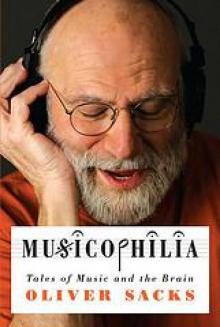 Musicophilia
Musicophilia The man who mistook his wife for a hat
The man who mistook his wife for a hat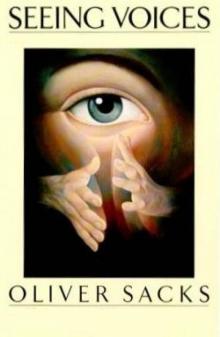 1989 - Seeing Voices
1989 - Seeing Voices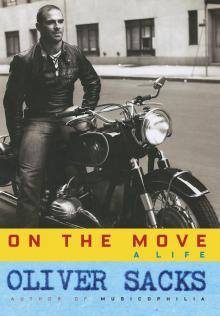 On the Move: A Life
On the Move: A Life 1996 - The Island of the Colorblind
1996 - The Island of the Colorblind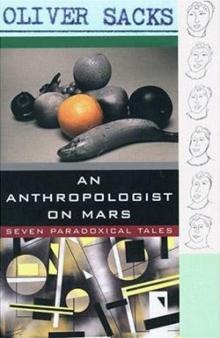 An Anthropologist on Mars: Seven Paradoxical Tales
An Anthropologist on Mars: Seven Paradoxical Tales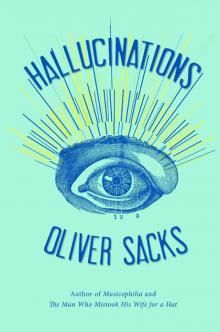 Hallucinations
Hallucinations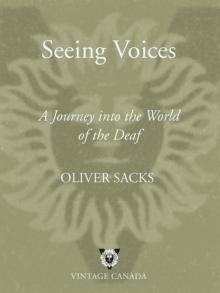 Seeing Voices
Seeing Voices The River of Consciousness
The River of Consciousness Vintage Sacks
Vintage Sacks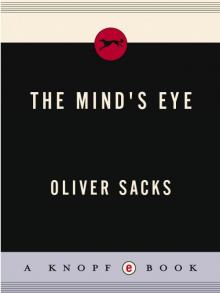 The Mind's Eye
The Mind's Eye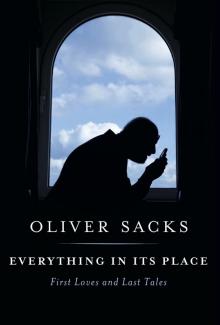 Everything in Its Place
Everything in Its Place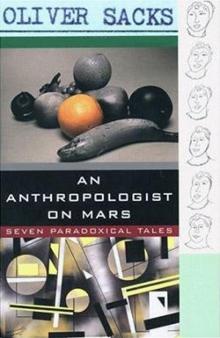 An Anthropologist on Mars (1995)
An Anthropologist on Mars (1995) Uncle Tungsten: Memories of a Chemical Boyhood (2001)
Uncle Tungsten: Memories of a Chemical Boyhood (2001)